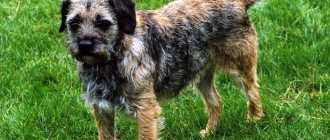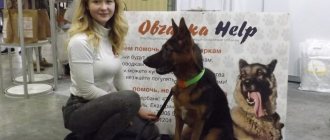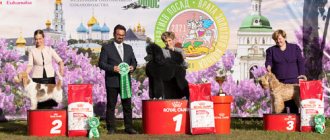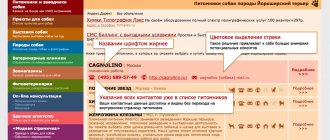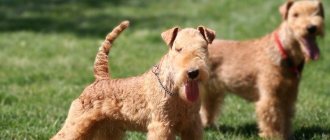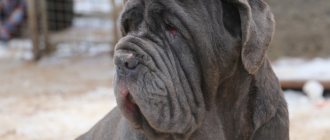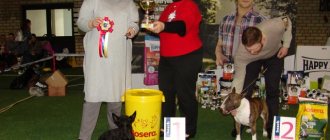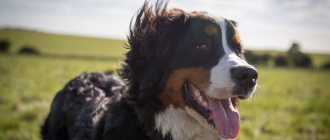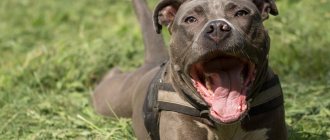The Pekingese is a popular toy dog. It belongs to the ancient breeds, bred in China more than 2 thousand years ago. Previously, Pekingese were called “sacred dogs of the house of Chinese emperors.” When other countries learned about them, they quickly spread throughout the world. Now everyone will recognize this dwarf dog with long hair and a flattened muzzle. She has a sweet, original appearance and a complex character. Thanks to their small size, Pekingese are easy to keep in a city apartment. But before you get this breed, you need to study its characteristics, pros and cons, and reviews from owners. A photo of Pekingese shows the characteristic appearance features:
- Interesting Facts
- Breed standard
- Education and training
- Pekingese coat care
Breed traits
Breed traits (on a 5-point scale)
| Pekingese | |||
| Activity | in the house | 2.8 | |
| on the street | 3 | ||
| Obedience | training | 2.5 | |
| strangers | 3.5 | ||
| Domination | in family | 2.8 | |
| over dogs | 3.5 | ||
| Defending your territory | from people | 3.5 | |
| from dogs | 3.5 | ||
| Sociability | in family | 4.8 | |
| with strangers | 3.3 | ||
| with dogs | 3 | ||
| Concentration | in family | 1.3 | |
| in front of strangers | 3 | ||
| with dogs | 2.8 | ||
| Aggressiveness | in family | 1.5 | |
| to strangers | 2.3 | ||
| to the dogs | 3 | ||
| to cats | 3 | ||
| Family behavior | calmness | 3 | |
| demand for affection | 4 | ||
| excitability | 3.8 | ||
| playfulness | 3.8 | ||
| excessive barking | 2 | ||
| behavioral breakdowns | 1.5 | ||
| Tolerance for children | up to 4 years | 2.8 | |
| over 4 years old | 3.8 | ||
| Institutional use | watchman | 3.5 | |
| bodyguard | 2.3 | ||
This breed is often compared to the following dog breeds: Pug, Shih Tzu, Yorkshire Terrier, Pomeranian, Chihuahua.
Muzzle
Group photo
Basic commands
You will use some commands more often, others less often. But they will still come in handy to easily interact with your Pekingese and even keep him safe in various situations.
- Aport. One of the most difficult teams. Many people perceive it as very easy and simple, but with many dogs you will have to work hard. This skill is used for other exercises: searching, searching, selecting an item and many others. Usually they are all used in service. When working out a command, “Aport” and “Give” are used, and a gesture is also used.
- Give. On the command “Give” the dog must give up the object.
- Lie. A connecting command that needs to be learned for other commands. In addition, it will not interfere at home or on the street.
- To me. You will need to use this command quite often. So start with it immediately after your Pekingese puppy has learned his name. Never call the dog to punish, and do not scold if it comes on its own, even after mischievousness before it. This behavior on your part may alienate the animal.
- Place. A puppy or an adult dog must clearly know where his place is located. He can sleep anywhere, if you allow it, of course, but he must know this command. You can use it outside the home, marking the place with a leash or your favorite toy.
- Near. It is possible to teach your pet the “Near” command at any age, be it an adult dog or a small puppy. When you move to a new home, you should immediately think about training your puppy.
- Sit. One of the very first commands that a Pekingese puppy should learn.
- Stand. The command is useful in everyday life, for example, for combing a dog.
- . The prohibiting command is one of the most mandatory and taming it begins from the first day the puppy appears in the house. Requiring the command “Fu!”, “No!”, “No!” - immediately stop the unwanted action.
Characteristics of the Pekingese breed
Many people know what a Pekingese looks like. But besides its doll-like appearance, this dog is famous for its regal habits. The breed was bred specifically for the Chinese emperors. From their pampered ancestors, the Pekingese inherited an independent, capricious character. These dogs love to be the center of attention and cannot tolerate rudeness or frequent hugs. An innate sense of aristocracy does not allow them to impose their company on the owner, show boredom by barking or chewing shoes. They show their dissatisfaction in a different way: they start doing what is forbidden, throwing things around. The video will tell you a lot of interesting things about representatives of this breed:
| Options | Characteristic |
| country of origin | China |
| IFF classification group | decorative |
| life expectancy | 13-15 years old |
| height | 15-25 cm |
| weight | male 3.2-5 kg, female 3.6-5.4 kg |
| aggressiveness | average |
| activity | low |
| security qualities | good |
| training | complex |
| care | difficult |
| health | weak |
pros
Many dog breeders consider the Pekingese to be the best companion and decorative pet for living in the city. The breed has gained popularity not only because it looks original. It has a few more advantages:
- Pekingese are suitable for keeping in a small apartment;
- there is no need to go for walks often; you can train yourself to go to the toilet while wearing a diaper;
- do not chew furniture or things;
- gets along well with small pets;
- smart, easy to remember commands;
- very loyal, kind, love to spend time with their owner, but are not intrusive, they understand when to leave.
Minuses
But Pekingese have disadvantages, which is why some dog breeders don’t like them:
- complex grooming;
- picky in choosing a diet;
- often get sick, have breathing problems, and suffer greatly from the heat in summer;
- stubborn, willful, jealous;
- constantly make some sounds: grunt, snore, sniffle, growl;
- do not tolerate strong hugs and may bite a child who behaves disrespectfully;
- They can play dirty tricks, take revenge, and with improper upbringing they become unbearable.
A few more interesting photos characterizing the habits of these dogs:
Red color
Who is the breed suitable for?
The Pekingese is not a breed for everyone. It is suitable for a person who is ready to treat their pet with respect, be proud of its uniqueness and pay attention to grooming. Due to its temperament and character, this dog will be an ideal companion for calm, neat owners, elderly people, the disabled and homebodies. The owner must be a responsible adult; children are not recommended to be trusted with caring for the pet. The Pekingese is difficult to train properly, as he is stubborn and independent, and strives to dominate. Therefore, it is suitable for experienced owners who can become a leader. It is not advisable to have this breed for families planning a child or having other pets. A video about the pros and cons of Pekingese will help you understand who these pets are suitable for:
Breeding
Breeding must be approached very responsibly. First of all, make sure that your dog does not have any pathologies. It is not advisable to breed animals from the same litter. It is also important to inquire about all the documents of your partner dog.
Estrus
If you are planning to breed your dog, keep a notebook and mark the beginning and end of the estrus there so you don’t miss the right day for breeding. Walking with a female dog during heat requires only a leash.
It is not advisable to breed animals from the same litter
Mating
The bitch is always taken to the dog's house, and not vice versa. In unfamiliar conditions, he may become confused and then fertilization will not be successful. It is not recommended to bathe animals before mating, so as not to wash away their natural odors. The bitch needs to be given a good walk on the day of mating. Due to the peculiarities of their physiology, Pekingese dogs get tired quickly, so it is necessary to constantly monitor the male’s well-being and take breaks after unsuccessful mountings.
If a dog gives birth for the first time, it is advisable to have a veterinarian attend the birth. A few hours before birth, mucus is released from the loop. Don't leave your pet alone from now on. After birth, you should not bring the cubs to the mother’s face - her reaction can be unpredictable.
If a dog gives birth for the first time, it is advisable to have a veterinarian attend the birth.
History of the origin of the Pekingese breed
Pekingese is one of the most ancient breeds, appearing more than 2000 years ago. Bred in China specifically for the emperor. No one but him had the right to keep such a dog. The Chinese called them Fu or Peking Palace Dog. According to legend, the origin of the Pekingese is unusual - they were descendants of a lion and a monkey. This explains the original appearance and proud independent character. Pekingese were considered sacred, people believed that they could ward off evil spirits and bring happiness. They were family members; when the emperor died, they were buried with him. Many images and figurines of such fluffy dogs were found in ancient tombs.
For a long time the breed was hidden, it was unknown in the world. Her fate was decided at the end of the 19th century. During the Opium War, soldiers from England stormed the imperial palace and discovered 5 dogs. They were taken to Great Britain, where they began to breed. The dogs became known as pekines because they were found in Beijing. At first they were kept only by members of the nobility; the breed was very rare. But by the beginning of the 20th century, it spread throughout Europe and gradually appeared in America. Clubs for Pekingese lovers began to be created, and the first breed standard appeared.
In China itself, with the communists coming to power, these dogs were considered a relic of the past and began to be destroyed. But thanks to the fact that by this time the breed had already spread throughout the world, it was saved from extinction. Now this is one of the most popular decorative dogs. During the selection process, breeders tried to preserve the breed characteristics, although this was difficult to do due to the small number of individuals. Therefore, modern Pekingese look a little different from the ancient representatives of the breed. They are larger, heavier, their legs are shorter, and their muzzle is more flattened. But these dogs retained their lion's mane and proud gait.
Interesting Facts
The world learned about this ancient breed only in the 19th century. But now many facts are known about what it was like before:
- in ancient China, only members of the nobility could keep such dogs;
- Pekingese were considered sacred dogs, ordinary people were forbidden to even look at them, and they were executed for theft;
- each dog had a servant, they were surrounded by care and fed from the imperial table;
- puppies were fed human breast milk;
- The external appearance of the Pekingese was strictly controlled; the dog had to be in harmony with the furniture and decorations in the palace.
Interesting ancient pictures showing the life of Pekingese in the imperial palace:
In the imperial palace
In the imperial palace
Owner reviews
“Very friendly dogs, good with children. We have had a pair of Pekingese dogs at home for five years now. It’s not difficult to care for them, the main thing is not to mess around, but to walk them for a long time. Otherwise, the dog may wither away right before our eyes.”
“I have been breeding dogs for a long time. I had to work with different breeds. Pekingese are one of my favorites. Very unpretentious, kind, in demand among clients. They adopted such a puppy into their family.”
Education University: Moscow State Academy of Veterinary Medicine. Year of graduation: 2010. Specialty: Veterinary medicine, Veterinary medicine. Experience I have experience working in a veterinary clinic for more than 7 years. Experience of the Federal State Budgetary Institution "All-Russian State Center for Quality and Standardization of Medicines for Animals and Feed"
People who have never had a dog think that keeping one is very easy. I put her on the bedding and the Pekingese tolerates it until he is taken for a walk. But this is not at all true; it is necessary to train the puppy to use the toilet. When becoming the owner of a baby, remember that he knows nothing about correct behavior. Training a dog must begin with training lessons.
Description of the appearance of Pekingese
Representatives of this breed are small in size, regal in posture and have an unusual appearance. They are easy to recognize simply by the description of their exterior features:
- small strong body;
- short legs;
- a very fluffy tail lying on the back;
- ears tilted forward, with feathering;
- the muzzle is short, flattened, there is a fold on the nose;
- big round eyes.
Breed standard
The first breed standard was created at the end of the 19th century. Its modified version, adopted in 2004, is now in effect. According to it, the height of an adult Pekingese at the withers should not be more than 25 cm, weight - up to 5.5 kg. Unlike representatives of other breeds, females weigh more than males. Photos complement the description of the appearance:
Appearance
Appearance
Head
The head is large and wide in relation to the body, the muzzle is short. The forehead is flat, the transition to the nose is pronounced, almost at a right angle. A small fold of skin runs from the bridge of the nose to the cheeks. She shouldn't close her eyes. The nose is black, flattened, the nostrils are large. The lower jaw protrudes. The lips are black and thin. The teeth are small, without spaces, and meet in a tight bite. The ears are heart-shaped. Covered with fluffy hair, they hang down, fitting tightly to the skull. The tips should not fall below the nose. The Pekingese's eyes are round and always dark. Large in relation to the muzzle, widely spaced. May be slightly convex, but not protruding. The look is smart, a little surprised. The eyelids are black and do not droop. The pictures show the structural features of the Pekingese head:
Head
Muzzle
Body type
The body is rectangular, compact, the back is straight. The chest is wide, the ribs are convex, and the waist is clearly defined. The neck is short, powerful, completely hidden by fluffy hair. The tail is set high, lies on the back, and is often tilted to the side.
Limbs
Limbs are parallel, of medium length. The front ones are thick, set wider than the rear ones, and more powerful. Elbows pressed to the body. The hock joints are clearly defined and located low. Pekingese paws are large and flat. They move slowly, waddle, but confidently. They don't like to run, but they are resilient when necessary. The body features of the Pekingese are visible in the photographs:
Body type
Body type
Features of Pekingese wool
The coat is straight, hard, medium length. Forms a fluffy collar and feathers on the paws. The longest hair is on the ears and tail. The undercoat is soft and fluffy, so the coat forms a halo around the body.
Colors
Now the standard allows several colors of the Pekingese:
- the most common color is from golden to dark red, black tan is possible;
- fawn, milky or cream, sometimes with a black muzzle;
- black Pekingese are popular;
- black and tan and black with white markings.
A dog of any color may have a white spot on its forehead. In ancient China, such dogs were believed to bring happiness. The standard does not allow colors such as gray, red, spotted. Pure white Pekingese are also not recognized, but are valued by fanciers. Photos showing the characteristics of wool and the variety of colors:
Summer on the grass
Black color
Varieties
There are no such varieties as the Royal, Imperial or Chinese Pekingese. But representatives of the breed are divided into two groups based on coat type. The standard and most common are the long-haired Pekingese. There is also a smooth-haired variety. Most often, black and white Pekingese have short hair. They have no feathering, ears are not fluffy and there is no thick undercoat. Such dogs, like shorn long-haired dogs, are not allowed to exhibit. There is also a dwarf variety of Pekingese. This is not a separate breed, but a subspecies not recognized by the standard. The weight of mini dogs is no more than 2.5 kg; they are not allowed for breeding, as they cannot bear offspring. Such dogs appear with standard parents and are popular. Dwarf varieties existed in ancient times. The Chinese wore them in the sleeves of their kimono and called them sleeve dogs.
Diseases and breed defects
The Pekingese's genetic predisposition to diseases is determined by the hereditary characteristics of the breed. Congenital and hereditary diseases of such a pet can be represented by:
- cataracts, which consist in changes in the structure of the eye lens and its clouding;
- distichiasis or abnormal eyelash growth;
- inversion and inversion of the eyelid;
- dermatitis in the folds of the muzzle;
- hemolytic anemia caused by a failure of autoimmune processes;
- hypoplasia of the teeth, causing immobility of the animal;
- hypothyroidism, accompanied by an insufficient amount of thyroid hormones;
- inguinal hernia;
- pathologies of intervertebral discs;
- keratitis and kerato-conjunctivitis;
- atresia of the lacrimal ducts and lens displacement;
- progressive retinal atrophy;
- ulcerative keratitis;
- umbilical hernia.
According to veterinarians, among Pekingese there are many “heart problems” and dogs with severe respiratory pathology . Also, joint diseases and eye problems, characteristic of domestic animals from the brachycephalic group, are not uncommon.
Pekingese personality
From ancient Chinese dogs, Pekingese inherited not only their regal appearance and posture. They have a complex, contradictory character. With members of his family he is a kind and affectionate pet, but with strangers he is wary and sometimes aggressive. He is calm, but always ready to support the game. Capable of protecting the owner from any threat, not only by barking, but also by rushing at the offender. It’s not for nothing that they said in China that this mini dog’s body contains the heart of a real lion. The royal habits have also been preserved.
Pekingese are proud, independent, proud and independent. They demand respect and do not tolerate rudeness. But they themselves also do not pester the owner, will not bark in vain and will calmly remain at home alone for several hours. The origin of the breed can be seen even in the dog’s gait, posture and gaze. If the pet is obsessive, cowardly or fussy, it is not a purebred Pekingese. These dogs are characterized by the following qualities:
- loyal, attached to all family members, difficult to bear separation;
- smart, quick-witted, capable of manipulation and cunning;
- are able to guess a person’s emotions and mood, can make them laugh, calm them down, and be there when they are sad;
- wayward, stubborn, do not always follow commands, strive for leadership;
- touchy, do not tolerate raising their voices, do not like prohibitions;
- selfish and jealous, the owner’s attention should be directed only to them;
- passive and phlegmatic, in adulthood they like to lie on the sofa;
- developed security qualities, protect the territory by barking, and can bite a stranger.
Pekingese have conflicting relationships with young children. Despite the fact that this dog is calm, phlegmatic and loves his family members, he can bite a child. Representatives of this breed do not tolerate familiar treatment, so they can react aggressively even to hugs. Pekingese also do not control themselves when eating and while playing. Dog handlers do not recommend having this breed for families with children. And if a dog is playing with a child, they should not be left alone. Even from the photographs one can see the proud disposition and royal bearing of these dogs:
Proud disposition and royal bearing
Education and training
Pekingese are dogs that require timely, competent socialization. Their character is genetically based on distrust of strangers and hostility towards other pets, especially dogs. They only recognize representatives of their own breed. This must be overcome as early as possible; it will be easier not only for the owners, but also for the pet itself.
Pekingese are difficult to train. They are smart, understand words and quickly learn commands. But they are not always followed, so they may seem stupid. But this dog is so stubborn that sometimes it is impossible to force him to do something he doesn’t want. Pekingese do not tolerate coercion. They may even go on a hunger strike just to get their way. Therefore, in training you need to show patience, perseverance and consistency. The owner needs to gain authority from the pet, and in classes find a way to interest him.
Training should be short and playful. In most cases, it is enough to teach the Pekingese basic commands: “come to me”, “place”, “sit”, “lie down”, “fu”, “no”. If he will not be exhibited, he does not require drill and a full course of training. This is not a dog that will perform complex tricks or constantly fetch the ball. Although some owners manage to teach their pet to give a paw, roll over, and dance. In addition to teaching commands from an early age, it is necessary to educate the dog. Understanding the rules of behavior will help to avoid problems when she grows up. Recommendations from dog handlers will help you understand what you need to pay attention to.
- Clear prohibitions that all family members must adhere to are important. The dog should not beg for food, jump on the bed, or bark a lot. There should be no concessions.
- Proper behavior requires rewards. Some dogs will benefit from affection, while others require a treat. Pekingese need to be praised even for small successes; they are sensitive to flattery.
- Punish only in a stern voice, expressing your dissatisfaction. Ignoring also works on Pekingese. You can’t scold too much, much less hit your pet. He may become embittered, vengeful and aggressive.
What to feed
Having decided to have this breed of dog at home, you need to decide what to feed the Pekingese. It is advisable that the diet does not differ significantly from the foods that the previous owners fed the puppy, at least at first, until he gets used to the new conditions. In the first months, the number of meals should be six times. Gradually, by nine months, feeding should be reduced to two times. It is desirable for a small puppy’s menu to include various cereal porridges - rice, millet, buckwheat and oatmeal. Not every puppy’s body will digest milk well; it is better to stick to fermented milk products and cottage cheese. Pekingese will eat fresh vegetables and seasonal fruits, both boiled and raw, with great pleasure. Beef, lamb, pork, poultry, and rabbit meat must be the main products in a dog’s diet. Pekingese, these decorative and principled dogs, love the attention of their owners so much that they are suitable only for those people who have enough time for long walks and entertainment with their pets. Their love of comfort and curiosity can bring their owners a lot of trouble. But loyalty and constant readiness to protect their owners will not leave anyone indifferent.
Caring for Pekingese dogs
This is a dog for keeping at home. But you need to make sure it doesn't get too hot. They cannot cool themselves like other dogs and their fur is thick and long. Therefore, it is recommended to install an air conditioner at home to maintain a normal temperature. Pekingese love to play when walking, but it is better not to let them off the leash. The pet can run away, loves to pester large dogs, and if there is a body of water nearby, it will definitely climb into it. Apart from grooming, this dog requires standard hygiene procedures:
- wipe your eyes once a week;
- check the ears every few days; their fluffy fur creates a favorable environment for the growth of bacteria;
- Brush your teeth 2-3 times a week;
- Check the nose fold regularly and, if necessary, dry it with a soft cloth or treat it with veterinary lotion;
- trim nails when they become visible from under the fur;
- Sometimes the hair on the paws and above the eyes needs to be trimmed.
This dog needs to be bathed as rarely as possible. Veterinarians recommend doing this 2-3 times a year. The rest of the time, use dry shampoo. Paws or belly that are dirty after a walk can be washed separately under running water.
Pekingese coat care
It is difficult to care for the Pekingese's coat; it needs to be brushed daily. The procedure takes 10-15 minutes, but if you do not do it regularly, the hair will fall off and tangles will form. When brushing your Pekingese, you can use a long-toothed comb or a stiff-bristled brush. The wool must first be moistened with water from a spray bottle or conditioner, then the hairs will not break. The fur that gets tangled the most is on the paws, tail, and ears. It is combed out with a metal comb. It is better to trim the hair between the fingers and above the eyes so that they do not interfere. Some owners give their pet a haircut. This is especially convenient in the summer, since Pekingese do not tolerate heat well. A pet with a haircut will suffer less, but it will no longer be allowed into the exhibition. You can trim your Pekingese at home or at a groomer. Video about combing and cutting a Pekingese:
What to feed Pekingese
Pekingese are picky eaters, prone to allergies and excess weight. Due to improper diet, their hair may fall out. Therefore, it is important to carefully choose what to feed your dog. The diet should contain sufficient amounts of protein and fat. Nutrients in industrial food are balanced. But Pekingese are picky, and they quickly get bored with monotonous dry food. This problem can be solved by adding canned food from the same manufacturer. You need to choose premium and super-premium food that does not contain wheat or corn. This diet is convenient for the owner and provides the pet with all the necessary microelements.
Using the recommendations on the packaging, it is easy to determine how much food your dog needs per day. It is usually recommended to give 60-100 g. When feeding natural food, the main place in the diet should be taken by lean meat. It is mixed with rice, buckwheat or oatmeal. You can also give offal, sea fish, eggs, cottage cheese, and fermented milk products. Fresh or boiled vegetables and fruits are healthy. You cannot give Pekingese food from your table, sausages, legumes, spicy and fatty foods, baked goods, and sweets. These dogs are prone to overeating, so it's best to ask your veterinarian how much food they need per day. You should not indulge your pets or give them pieces, as they quickly gain weight.
Health and illness
When favorable conditions are created, Pekingese live 13-15 years. But these dogs are in poor health. They are prone to some congenital and acquired diseases:
- pathologies of joints and intervertebral discs;
- entropion, cataracts, dry eye syndrome, retinal atrophy and other eye diseases;
- folded dermatitis;
- hair loss;
- mitral valve pathology.
Breathing problems are especially common. This is a brachycephalic breed, so it is difficult for the dog to even take a breath. For this reason, Pekingese often snore, grunt, and make other sounds. It is also difficult for them to tolerate heat and run a lot. It is recommended to take him out for walks in a harness, as the collar further impairs breathing.
Sometimes Pekingese owners are faced with such a problem that their pet's eye has fallen out. This pathology is called eyeball luxation. Only found in flat-faced dogs. Due to their special structure, the eyeballs fall out during injury or severe stress. Even careless handling of your pet can lead to this. When an eye falls out, the owners get scared. But if you immediately contact a veterinarian, your pet’s vision will be preserved.
The health of the Pikinese requires special attention. They are weak and painful, prone to allergies and digestive disorders. Such dogs cannot bear and give birth to puppies, therefore they are not allowed for exhibitions and breeding. To protect your pet from infections, you need to give him all the necessary vaccinations on time. It is recommended to give anthelmintic drugs once every three months, and to treat for parasites every month in the warm season. Regular examinations by a veterinarian will help to identify health problems early and avoid complications. The video will show what you need to be prepared for when you get a dog of this breed:
Nutritional Features
Do not forget that Pekingese dogs are decorative pets. Therefore, they need a special diet. The Pekingese's diet should be balanced and dietary, because excess weight contributes to the development of diseases of the digestive tract and respiratory organs in the animal.
You can create a diet from both special dry food and natural products. If you adhere to a natural diet, it is worth remembering some rules. Frequently changing the diet will not be beneficial for your pet. The amount of protein food should be twice as much as vegetable food.
Do not add too much salt to food, and also do not give your pet too hot food. It is forbidden to give your Pekingese fatty, smoked food, or sugar. Potatoes and beans are also not recommended.
Pekingese puppies
On average, the price of a representative of this breed in Moscow ranges from 25 to 40 thousand rubles. Pedigree show class puppies with good pedigree cost more. You should not buy Pekingese from someone else or from the market. If the price is low, this may indicate an unscrupulous breeder who does not care about preserving the breed's qualities. Such a puppy may grow up to be a mixed breed or a sick dog. Therefore, you first need to find out how much a purebred dog should cost.
It is better to contact a well-known nursery. You need to study reviews about him, get to know the breeder and the conditions under which the animals are kept. It is recommended to examine the parents; they should not have very bulging eyes. This problem is inherited, and sometimes the eyeballs fall out. When choosing a Pekingese puppy, you need to pay attention to the following signs:
- the eyes are clean, without tearing, the look is interested;
- nose black, wet;
- ears without discharge;
- the wool is clean, without bald spots;
- active and playful behavior.
Beautiful pictures of Pekingese puppies can be found on the website of any nursery:
Puppies
Puppy
Before buying a puppy, it is worth studying one more video about the features of this breed:
The Pekingese is an unusual dog. She is ideal for urban conditions and lives quietly even in a small apartment. Royal origin left its mark on the character and habits of its representatives. All Pekingese behave with dignity, have a proud posture and an independent disposition. To make this dog a loyal friend and an obedient pet, you need to put in a lot of effort.
Vaccination
Caring for a Pekingese puppy includes timely vaccination of the pet. The first vaccinations are given by the breeder, which will be recorded with a note in the animal’s passport.
The puppy is given the first vaccine at 1 month. A few days before this, it is imperative to prevent helminth infection.
The next vaccination is given after a month and a half. The baby will receive his last injection at 4 months, after which he can be taken outside.
Important! We must not forget about annual vaccinations, which will protect the Pekingese from many contagious and deadly diseases.
Where to buy and what to look for
To buy a purebred and healthy animal, you need to adhere to the following recommendations:
- You need to purchase a Pekingese puppy from nurseries or from well-established, experienced breeders;
- during the selection process, it is advisable to view several litters of the breed at once in different nurseries;
- the age of the pet being sold must not be less than two months;
- before purchasing, you must find out whether deworming and vaccination have been carried out according to age;
- a prerequisite is the conclusion of an agreement that stipulates bilateral responsibility, and a clause on the possibility of returning the animal within a certain time.
Important! Experienced breeders will not guarantee that a puppy is in the “show class” until the age of six months.
It is important to remember that if you plan to purchase an exhibition animal or one participating in breeding, you must obtain a guarantee from the nursery. It is also necessary to take into account that the only official representative of the FCI in our country is the RKF .
